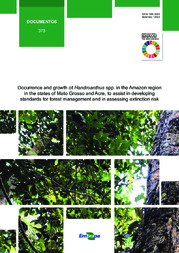Occurrence and growth of Handroanthus spp. in the Amazon region in the states of Mato Grosso and Acre, to assist in developing standards for forest management and in assessing extinction risk.
Occurrence and growth of Handroanthus spp. in the Amazon region in the states of Mato Grosso and Acre, to assist in developing standards for forest management and in assessing extinction risk.
Autoria: BRAZ, E. M.; CANETTI, A.; MATTOS, P. P. de; OLIVEIRA, M. V. N. d'; THAINES, F.; OLIVEIRA, M. F.; GARRASTAZU, M. C.
Resumo: Foreword It is always gratifying to be able to help advance research on native tree species and provide results to the community. Research on the occurrence of wood-producing species from native forests is strategically important for Brazil, in terms of the environment as well as the economy, and motivated the Embrapa Forestry team and its collaborators to conduct this research on Handroanthus spp. in two Brazilian states. The area where species in this genus occur is presented along with considerations about populations, growth, and structure, carrying capacity and stock managed native forests, as well as other analyses. Results from analyses of production under different forest management conditions are also presented. This data is essential not only for environmental organizations but also for the productive sector, academia, research and government institutions, and technicians that are directly or indirectly involved with management of native forests. This project is in line with Sustainable Development Goals 6, 8, 12, 15, and 17, since it addresses increased productivity and maintaining forest cover through managing native forests, involving systems that help boost efficient use of these natural resources and also promoting ecosystem conservation and biodiversity preservation. This text is the result of collaboration between different institutions and actors that work toward sustainable management of wood species in the Amazon Forest. We hope that the data provided here will fill in the gaps on this topic, with a new focus on procedures for analyzing native tree species.
Ano de publicação: 2022
Tipo de publicação: Livros
Unidade: Embrapa Florestas
Observações
1 - Por padrão são exibidas publicações dos últimos 20 anos. Para encontrar publicações mais antigas, configure o filtro ano de publicação, colocando o ano a partir do qual você deseja encontrar publicações. O filtro está na coluna da esquerda na busca acima.
2 - Para ler algumas publicações da Embrapa (apenas as que estão em formato ePub), é necessário ter, no celular ou computador, um desses softwares gratuitos. Sistemas Android: Google Play Livros; IOS: iBooks; Windows e Linux: software Calibre.
Acesse outras publicações
Acesse a Base de Dados da Pesquisa Agropecuária (BDPA) para consultar o acervo completo das bibliotecas da Embrapa.

